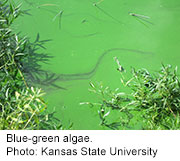
TUESDAY, July 30 (HealthDay News) — Blue-green algae is found in lakes and ponds across the United States and is a threat to both people and pets, an expert warns.
Toxins produced by blue-green algae are hazardous to people and can be fatal in animals, particularly dogs, said Deon van der Merwe, associate professor of diagnostic medicine and pathobiology at Kansas State University.
“Essentially anywhere there is water, you can find blue-green algae,” van der Merwe said in a university news release.
“If there is a lot of sunshine and if the weather is warm, that makes it easier for them to grow rapidly,” said van der Merwe, who also manages the toxicology section of the Kansas State Veterinary Diagnostic Laboratory. “That’s why blooms occur most frequently in the summer, especially in drought conditions. Under drought conditions, you typically have many cloudless days and more sunlight reaching water.”
Animals exposed to toxins from blue-green algae can experience vomiting or diarrhea. High levels of exposure to the toxins can cause them to experience liver failure and may be deadly. Gastrointestinal symptoms and liver failure also can occur in people exposed to these toxins, but symptoms such as skin rashes, sneezing, coughing, eye irritation and runny nose are more common in humans.
“If you go to a lake or pond and the water is green, it is important to avoid physical contact with that water,” van der Merwe said. “If people swim or ski behind a boat and they inhale spray from behind that boat, those can also be situations in which people can be exposed.”
“If people suspect that their dog has been exposed and the dog starts to vomit, that is often the first sign you will see,” van der Merwe said. “It is very important to get the dog to the veterinarian as soon as possible. It may be possible to do preventive treatment to stop the full development of the poisoning.”
Pet owners also need to protect themselves by wearing protective gloves when handling animals that have been exposed to blue-green algae.
In addition, blue-green algae can affect other animals — such as birds, deer, cattle, horses and other livestock — that use open water, van der Merwe said.
More information
The Kansas Department of Health and Environment has more about blue-green algae.
Copyright © 2026 HealthDay. All rights reserved.

